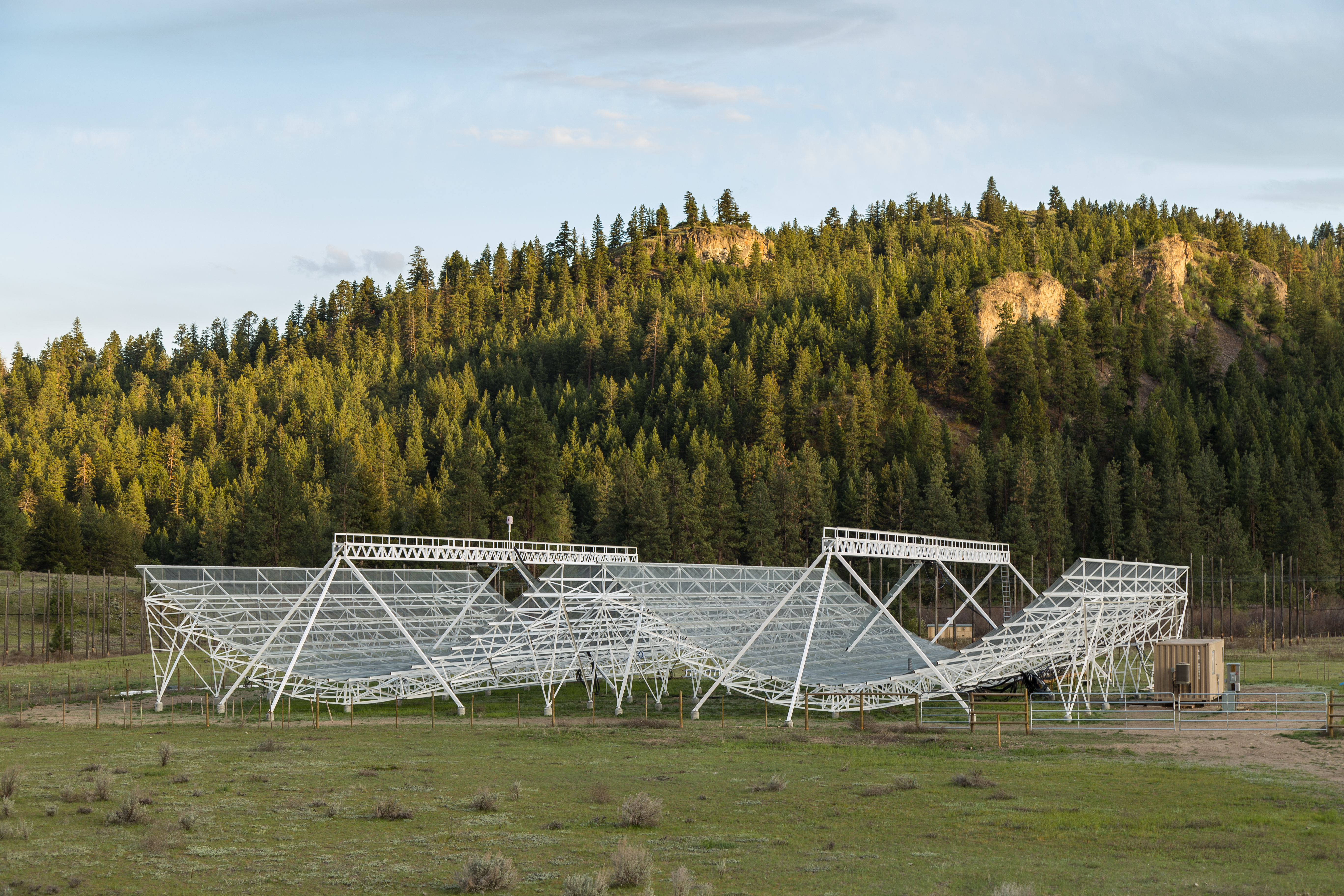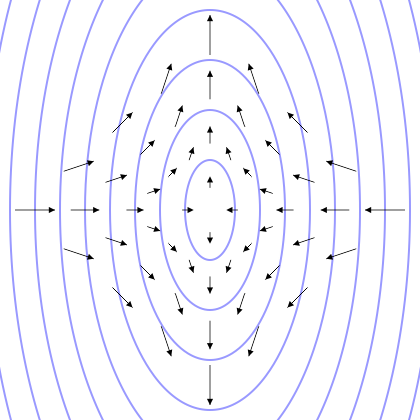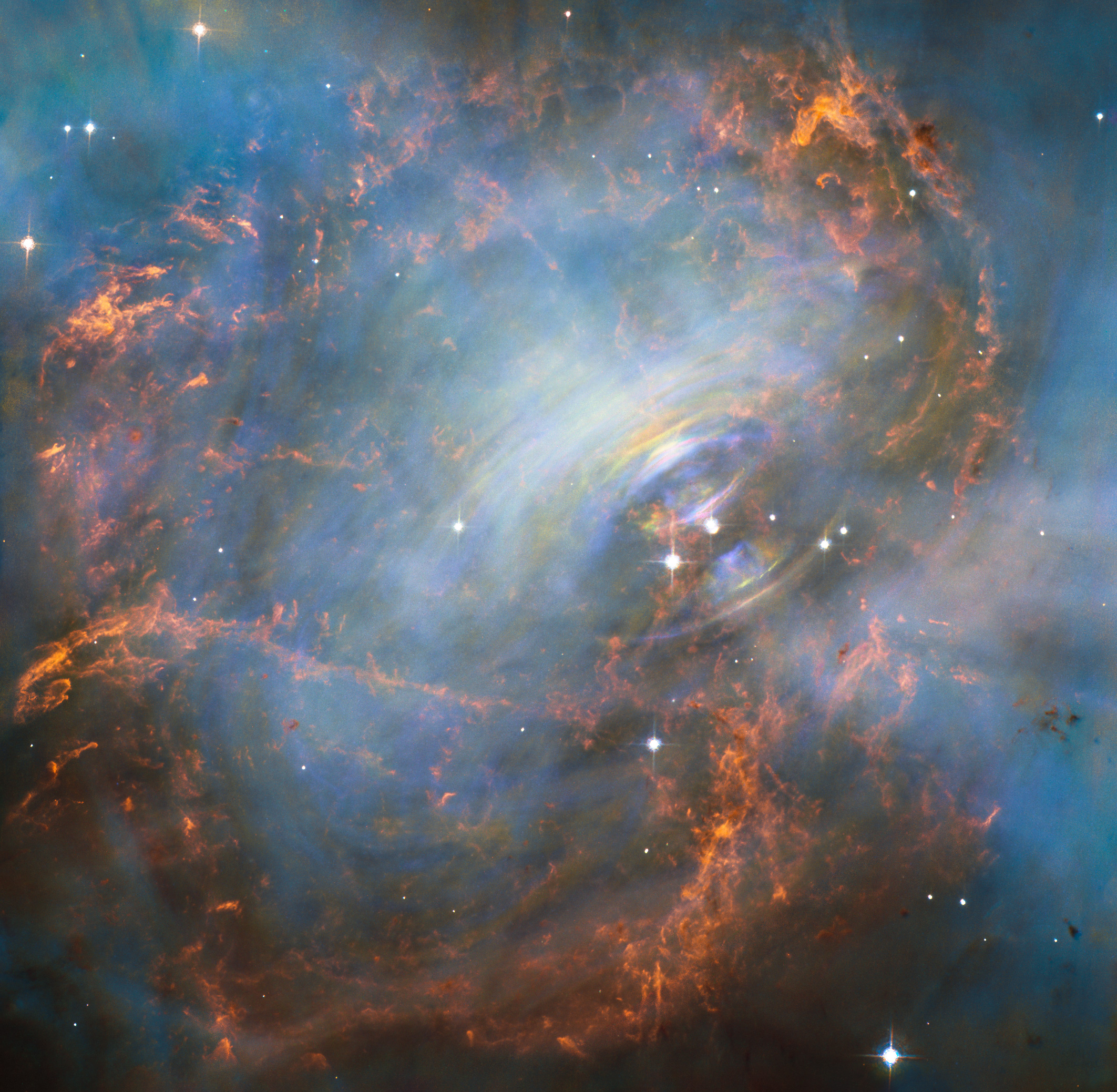|
Canadian Hydrogen Intensity Mapping Experiment
The Canadian Hydrogen Intensity Mapping Experiment (CHIME) is an interferometric radio telescope at the Dominion Radio Astrophysical Observatory in British Columbia, Canada which consists of four antennas consisting of 100 x 20 metre cylindrical parabolic reflectors with 1024 dual-polarization radio receivers suspended on a support above them. The antenna receives radio waves from hydrogen in space at frequencies in the 400–800 MHz range. The telescope's low-noise amplifiers are built with components adapted from the cellphone industry and its data processed using a custom-built FPGA electronic system and 1000-processor high-performance GPGPU cluster. The telescope has no moving parts and observes half of the sky each day as the Earth turns. It has also turned out to be a great instrument for observing fast radio bursts (FRBs). CHIME is a partnership between the University of British Columbia, McGill University, the University of Toronto and the Canadian National Research ... [...More Info...] [...Related Items...] OR: [Wikipedia] [Google] [Baidu] |
Interferometer
Interferometry is a technique which uses the '' interference'' of superimposed waves to extract information. Interferometry typically uses electromagnetic waves and is an important investigative technique in the fields of astronomy, fiber optics, engineering metrology, optical metrology, oceanography, seismology, spectroscopy (and its applications to chemistry), quantum mechanics, nuclear and particle physics, plasma physics, biomolecular interactions, surface profiling, microfluidics, mechanical stress/strain measurement, velocimetry, optometry, and making holograms. Interferometers are devices that extract information from interference. They are widely used in science and industry for the measurement of microscopic displacements, refractive index changes and surface irregularities. In the case with most interferometers, light from a single source is split into two beams that travel in different optical paths, which are then combined again to produce interference; two ... [...More Info...] [...Related Items...] OR: [Wikipedia] [Google] [Baidu] |
McGill University
McGill University (French: Université McGill) is an English-language public research university in Montreal, Quebec, Canada. Founded in 1821 by royal charter,Frost, Stanley Brice. ''McGill University, Vol. I. For the Advancement of Learning, 1801–1895.'' McGill-Queen's University Press, 1980. the university bears the name of James McGill, a Scottish merchant, whose bequest in 1813 established the University of McGill College. In 1885, the name of the university was officially changed to McGill University. Its main campus is on the slope of Mount Royal in downtown Montreal in the borough of Ville-Marie, with a second campus situated in Sainte-Anne-de-Bellevue, west of the main campus on Montreal Island. The university is one of two members of the Association of American Universities located outside the United States, alongside the University of Toronto, and is the only Canadian member of the Global University Leaders Forum (GULF) within the World Economic Forum. The ... [...More Info...] [...Related Items...] OR: [Wikipedia] [Google] [Baidu] |
Gravitational Wave
Gravitational waves are oscillations of the gravitational field that Wave propagation, travel through space at the speed of light; they are generated by the relative motion of gravity, gravitating masses. They were proposed by Oliver Heaviside in 1893 and then later by Henri Poincaré in 1905 as the gravitational equivalent of Electromagnetic radiation, electromagnetic waves. In 1916, Albert Einstein demonstrated that gravitational waves result from his general theory of relativity as ripples in spacetime. Gravitational waves transport energy as gravitational radiation, a form of radiant energy similar to electromagnetic radiation. Newton's law of universal gravitation, part of classical mechanics, does not provide for their existence, instead asserting that gravity has instantaneous effect everywhere. Gravitational waves therefore stand as an important relativistic phenomenon that is absent from Newtonian physics. Gravitational-wave astronomy has the advantage that, unlike elec ... [...More Info...] [...Related Items...] OR: [Wikipedia] [Google] [Baidu] |
Pulsars
A pulsar (''pulsating star, on the model of quasar'') is a highly magnetized rotating neutron star that emits beams of electromagnetic radiation out of its magnetic poles. This radiation can be observed only when a beam of emission is pointing toward Earth (similar to the way a lighthouse can be seen only when the light is pointed in the direction of an observer), and is responsible for the pulsed appearance of emission. Neutron stars are very dense and have short, regular rotational periods. This produces a very precise interval between pulses that ranges from milliseconds to seconds for an individual pulsar. Pulsars are one of the candidates for the source of ultra-high-energy cosmic rays (see also centrifugal mechanism of acceleration). Pulsars’ highly regular pulses make them very useful tools for astronomers. For example, observations of a pulsar in a binary neutron star system were used to indirectly confirm the existence of gravitational radiation. The first ext ... [...More Info...] [...Related Items...] OR: [Wikipedia] [Google] [Baidu] |
Gravitational Waves
Gravitational waves are oscillations of the gravitational field that travel through space at the speed of light; they are generated by the relative motion of gravitating masses. They were proposed by Oliver Heaviside in 1893 and then later by Henri Poincaré in 1905 as the gravitational equivalent of electromagnetic waves. In 1916, Albert Einstein demonstrated that gravitational waves result from his general theory of relativity as ripples in spacetime. Gravitational waves transport energy as gravitational radiation, a form of radiant energy similar to electromagnetic radiation. Newton's law of universal gravitation, part of classical mechanics, does not provide for their existence, instead asserting that gravity has instantaneous effect everywhere. Gravitational waves therefore stand as an important relativistic phenomenon that is absent from Newtonian physics. Gravitational-wave astronomy has the advantage that, unlike electromagnetic radiation, gravitational waves are not a ... [...More Info...] [...Related Items...] OR: [Wikipedia] [Google] [Baidu] |
Neutron Stars
A neutron star is the gravitationally collapsed core of a massive supergiant star. It results from the supernova explosion of a massive star—combined with gravitational collapse—that compresses the core past white dwarf star density to that of atomic nuclei. Surpassed only by black holes, neutron stars are the second smallest and densest known class of stellar objects. Neutron stars have a radius on the order of and a mass of about . Stars that collapse into neutron stars have a total mass of between 10 and 25 solar masses (), or possibly more for those that are especially rich in elements heavier than hydrogen and helium. Once formed, neutron stars no longer actively generate heat and cool over time, but they may still evolve further through collisions or accretion. Most of the basic models for these objects imply that they are composed almost entirely of neutrons, as the extreme pressure causes the electrons and protons present in normal matter to combine into additi ... [...More Info...] [...Related Items...] OR: [Wikipedia] [Google] [Baidu] |
Proceedings Of SPIE
''Proceedings of SPIE'' is the conference record of the Society of Photo-Optical Instrumentation Engineers (SPIE). SPIE The first proceedings were published in 1963. Indexing and abstracting ''Proceedings of SPIE'' is indexed and abstracted in:References External links * Optics journals Academic journals established in 1963 Conference proceedings published in serials SPIE academic j ...[...More Info...] [...Related Items...] OR: [Wikipedia] [Google] [Baidu] |
Galactic Magnetic Fields
A galaxy is a system of stars, stellar remnants, interstellar gas, dust, and dark matter bound together by gravity. The word is derived from the Greek ' (), literally 'milky', a reference to the Milky Way galaxy that contains the Solar System. Galaxies, averaging an estimated 100 million stars, range in size from dwarfs with less than a thousand stars, to the largest galaxies known – supergiants with one hundred trillion stars, each orbiting its galaxy's centre of mass. Most of the mass in a typical galaxy is in the form of dark matter, with only a few per cent of that mass visible in the form of stars and nebulae. Supermassive black holes are a common feature at the centres of galaxies. Galaxies are categorised according to their visual morphology as elliptical, spiral, or irregular. The Milky Way is an example of a spiral galaxy. It is estimated that there are between 200 billion () to 2 trillion galaxies in the observable universe. Most galaxies are 1,000 to 100 ... [...More Info...] [...Related Items...] OR: [Wikipedia] [Google] [Baidu] |
Milky Way
The Milky Way or Milky Way Galaxy is the galaxy that includes the Solar System, with the name describing the #Appearance, galaxy's appearance from Earth: a hazy band of light seen in the night sky formed from stars in other arms of the galaxy, which are so far away that they cannot be individually distinguished by the naked eye. The Milky Way is a barred spiral galaxy with a Galaxy#Isophotal diameter, D25 isophotal diameter estimated at , but only about 1,000 light-years thick at the spiral arms (more at the bulge). Recent simulations suggest that a dark matter area, also containing some visible stars, may extend up to a diameter of almost 2 million light-years (613 kpc). The Milky Way has several List of Milky Way's satellite galaxies, satellite galaxies and is part of the Local Group of galaxies, forming part of the Virgo Supercluster which is itself a component of the Laniakea Supercluster. It is estimated to contain 100–400 billion stars and at least that number of pla ... [...More Info...] [...Related Items...] OR: [Wikipedia] [Google] [Baidu] |
Lambda-CDM Model
The Lambda-CDM, Lambda cold dark matter, or ΛCDM model is a mathematical model of the Big Bang theory with three major components: # a cosmological constant, denoted by lambda (Λ), associated with dark energy; # the postulated cold dark matter, denoted by CDM; # ordinary matter. It is the current ''standard model'' of Big Bang cosmology, as it is the simplest model that provides a reasonably good account of: * the existence and structure of the cosmic microwave background; * the large-scale structure in the distribution of galaxies; * the observed abundances of hydrogen (including deuterium), helium, and lithium; * the accelerating expansion of the universe observed in the light from distant galaxies and supernovae. The model assumes that general relativity is the correct theory of gravity on cosmological scales. It emerged in the late 1990s as a concordance cosmology, after a period when disparate observed properties of the universe appeared mutually inconsistent, and ... [...More Info...] [...Related Items...] OR: [Wikipedia] [Google] [Baidu] |
Dark Energy
In physical cosmology and astronomy, dark energy is a proposed form of energy that affects the universe on the largest scales. Its primary effect is to drive the accelerating expansion of the universe. It also slows the rate of structure formation. Assuming that the lambda-CDM model of cosmology is correct, dark energy dominates the universe, contributing 68% of the total energy in the present-day observable universe while dark matter and Baryon#Baryonic matter, ordinary (baryonic) matter contribute 27% and 5%, respectively, and other components such as neutrinos and photons are nearly negligible.Sean Carroll, Ph.D., Caltech, 2007, The Teaching Company, ''Dark Matter, Dark Energy: The Dark Side of the Universe'', Guidebook Part 2. p. 46. Retrieved 7 October 2013, "...dark energy: A smooth, persistent component of invisible energy, thought to make up about 70 percent of the energy density of the universe. Dark energy is smooth because it doesn't accumulate preferentially in galaxi ... [...More Info...] [...Related Items...] OR: [Wikipedia] [Google] [Baidu] |
Metric Expansion Of Space
The expansion of the universe is the increase in distance between gravitationally unbound parts of the observable universe with time. It is an intrinsic expansion, so it does not mean that the universe expands "into" anything or that space exists "outside" it. To any observer in the universe, it appears that all but the nearest galaxies (which are bound to each other by gravity) move away at speeds that are proportional to their distance from the observer, on average. While objects cannot move faster than light, this limitation applies only with respect to local reference frames and does not limit the recession rates of cosmologically distant objects. Cosmic expansion is a key feature of Big Bang cosmology. It can be modeled mathematically with the Friedmann–Lemaître–Robertson–Walker metric (FLRW), where it corresponds to an increase in the scale of the spatial part of the universe's spacetime metric tensor (which governs the size and geometry of spacetime). Within ... [...More Info...] [...Related Items...] OR: [Wikipedia] [Google] [Baidu] |








